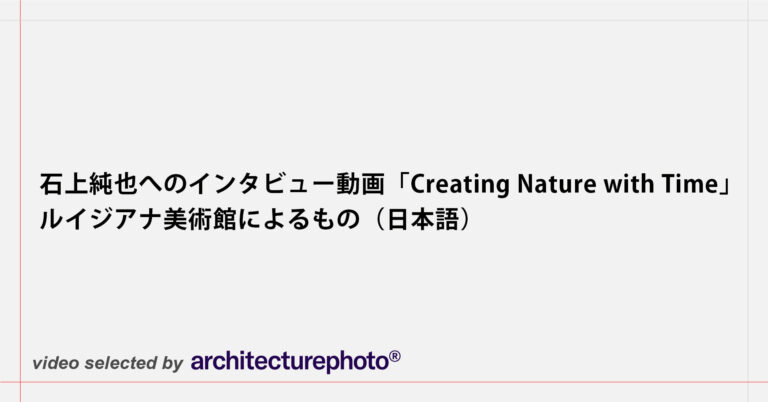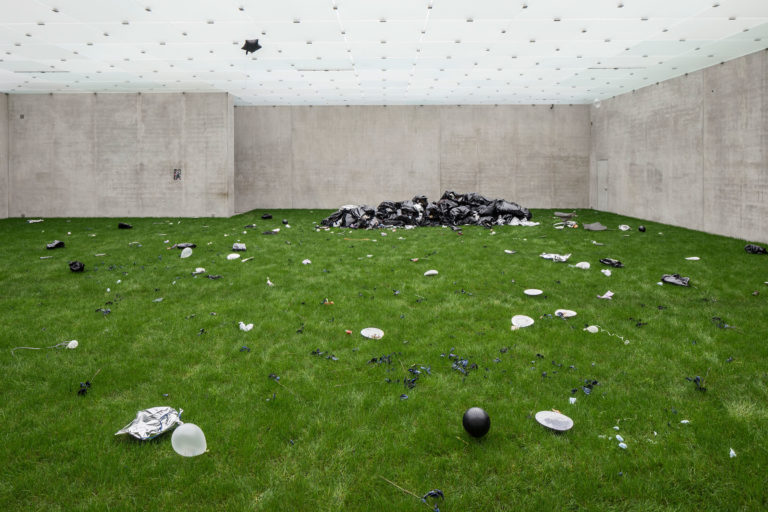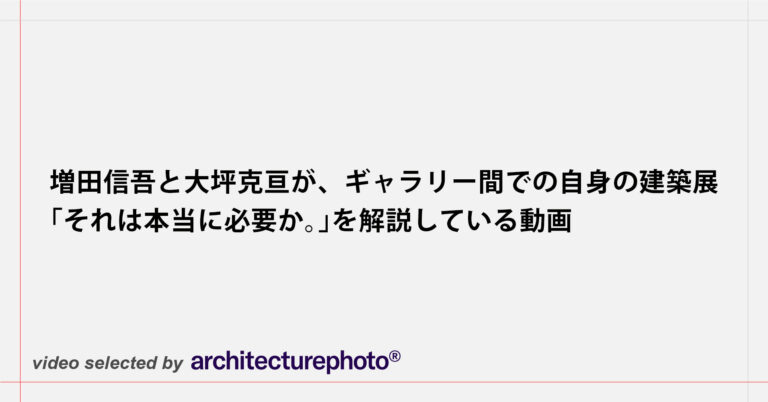アーティストのルーチョ・フォンタナの、アメリカ・ロサンゼルスのギャラリー ハウザー&ワースでの展覧会「Walking the Space: Spatial Environments, 1948 – 1968」の会場動画です。展示は2020年4月12日まで。公式ページはこちら。
video archive
森美術館での展覧会「未来と芸術展:AI、ロボット、都市、生命 ― 人は明日どう生きるのか」の会場動画です。会期は2020年3月29日まで。山梨知彦、五十嵐太郎、WOHA、ビャルケ・インゲルス、MAD、竹中工務店などが出展、noizが関わったインスタレーションも見ることができます。出展者の詳細はこちらでどうぞ。
以下は展覧会公式の概要。
テクノロジーの発達は、いま、私たちの生活のさまざまな側面に大きな影響を与えようとしています。近い将来、人間は多くの判断を AI(人工知能)に任せるようになり、AIが人類の知能を超え、私たちの社会や生活に急激な変化をもたらす「シンギュラリティ」が到来すると言われています。また、ブロックチェーン技術は、社会システムに新たな信用と価値を作り出し、多様なバイオ技術は、食や医学、そして環境に多大な影響を与えることになるでしょう。私たち人間が身体機能を拡張させ、いま以上に長寿を享受する時代もそう遠くない話なのかもしれません。そうした急激な変化がもたらす未来は決して明るいものだけではないかもしれませんが、私たちは、少なくとも20-30年後の未来のヴィジョンについて考えることが必要なのではないでしょうか。それは同時に、豊かさとは何か、人間とは何か、生命とは何かという根源的な問いにもつながるのです。
本展は、「都市の新たな可能性」、「ネオ・メタボリズム建築へ」、「ライフスタイルとデザインの革新」、「身体の拡張と倫理」、「変容する社会と人間」の5つのセクションで構成し、100点を超えるプロジェクトや作品を紹介します。AI、バイオ技術、ロボット工学、AR(拡張現実)など最先端のテクノロジーとその影響を受けて生まれたアート、デザイン、建築を通して、近未来の都市、環境問題からライフスタイル、そして社会や人間のあり方をみなさんと一緒に考える展覧会です。
藤野高志 / 生物建築舎が、斜面地に計画中の住宅「ケーブルカー」の設計プロセスを解説している動画です。2019年11月~2020年2月までGAギャラリーで行われた展覧会「設計のプロセス」で公開された動画のようです。
OMAのレム・コールハースとAMOディレクターのサミール・バンタル(Samir Bantal)らによる、2020年2月にグッゲンハイム美術館で始まる”田舎”をテーマにした建築展「Countryside, The Future」の予告動画が公開されています。会期は2020年2月20日~8月14日。展覧会の公式サイトはこちら。
Countryside, The Future, is an exhibition addressing urgent environmental, political, and socioeconomic issues through the lens of architect and urbanist Rem Koolhaas and Samir Bantal, Director of AMO, the think tank of the Office for Metropolitan Architecture (OMA). A unique exhibition for the Guggenheim Museum, Countryside, The Future will explore radical changes in the rural, remote, and wild territories collectively identified here as “countryside,” or the 98% of the earth’s surface not occupied by cities, with a full rotunda installation premised on original research. The project presents investigations by AMO, Koolhaas, with students at the Harvard Graduate School of Design; the Central Academy of Fine Arts, Beijing; Wageningen University, Netherlands; and the University of Nairobi. The exhibition will examine the modern conception of leisure, large scale planning by political forces, climate change, migration, human- and non-human ecosystems, market driven preservation, artificial and organic coexistence and other forms of radical experimentation that are altering the landscapes across the world.
こちらは2015年にハーバード大学で行われたコールハースによる、田舎(Countryside)をテーマに行われた簡単な公演の動画。また2012年にコールハースが同テーマで行った講演のスライドがこちらで公開されています。
王立英国建築家協会による2020年のRIBAゴールドメダルを受賞した、グラフトン・アーキテクツの受賞記念講演の動画です。2020年2月12日に行われたものです。
アーティストのジェームス・タレルが、ライフワークとして1979年から取り組んでいるアリゾナ州のクレータを敷地とする作品「ローデン・クレーター」を紹介する動画です。ロサンゼルス・カウンティ美術館で2013-2014年に行われたタレルの回顧展で展示されたものです。タレルのインタビューも収録。
柄沢祐輔による、2019年10月に行われたTEDxSapporoでの講演「アルゴリズムによるネットワーク建築」の動画です。
柄沢祐輔は、複雑系の科学が解明した自然界の秩序と多様性を建築にも反映できるのではないかと、アルゴリズム建築を探求。
秩序を持った多様な形を持つ建築を生み出すことで、新たな発見ができる空間をつくり、建築の可能性を大きく広げている。
石上純也への、ルイジアナ美術館によるインタビュー動画「Creating Nature with Time」が公開されています。日本語で聞けるインタビューです。
“If things created by humans should function next to natural things, the passing of time is necessary. Only the passage of time will bring forward the kind of landscape I want to create,” says the renowned Japanese architect Junya Ishigami. Learn about his award-winning project, the poetic landscape ‘Water Garden’, in this short video.
When a hotel owner hired Ishigami to create a new garden and an addition to his hotel, the premise was that the addition should be built in a forest, and the garden in an area with meadows alongside. Because they were only allowed to build in the woods – meaning having to cut down almost all of the trees – Ishigami decided “to move all the trees from the forest and create a new forest.” Each tree was carefully relocated, uprooted and replanted over four years. They also relocated the moss that was already there, used the existing stones to make stepping stones, and integrated the water in the area: “We used everything that was already there and changed the layout to create a new artificial environment that was as close as possible to something natural,” Ishigami says. In continuation of this, 50 years earlier, the location had been rice paddies, and so Ishigami wanted to combine the rice paddy landscape with the forest landscape. Ishigami explains how it wasn’t about creating something from nothing, but rather about using the already existing environment and “letting the passage of time create a new garden. So, the concept was that the garden would take a long time to mature.”
アーティストの白髪一雄の、東京オペラシティアートギャラリーでの回顧展の会場動画です。会期は2020年3月22日まで。
以下は展覧会公式の概要。
白髪一雄は、戦後日本の前衛芸術を牽引した具体美術協会の中心メンバーとして知られ、近年改めて国際的に熱い注目を集めています。兵庫県尼崎市に生まれた白髪は、具体美術協会に参加する前年の1954年より、床に広げた支持体に足で直接描く「フット・ペインティング」の制作を始め、その実践と探求により、未知の領域を切り拓いてゆきます。
従来は制作の手段にすぎなかった身体運動(アクション/パフォーマンス)をまさに画面の主役に据えるそのラディカルな方法は、既存の芸術的、社会的な常識を一気に飛び越え、人間がものを作る行為の原初にたち返る画期的なアイデアでした。
具体美術協会解散後も先鋭な制作原理を貫いた白髪の作品は、空間や時間、物質や運動のなかで人間存在のすべてを燃焼させる圧倒的な力をはらんでおり、同時に、絵具の滴り、滲み、粘性や流動性、堅牢さ、といった油彩画ならではの魅力を豊かに備えています。
白髪の探求は、人間の資質と感覚をいかに高めるかという問題や、宗教的な精神性の問題など、独自の人間学的アプローチを含んでおり、様々な視点からの検証を待っています。
白髪の没後10年以上を経て開催する本展は、東京で初の本格的な個展として、初期から晩年までの絵画約90点をはじめ、実験的な立体作品や伝説的パフォーマンスの映像、ドローイングや資料も加え、総数約130点で作家の活動の全容に迫ります。

ブレゲンツ美術館で行われている、アーティストのバニー・ロジャース(Bunny Rogers)のインスタレーション展「Kind Kingdom」の会場動画です。ブレゲンツ美術館はピーター・ズントーの設計でも知られています。展覧会の公式サイトはこちら。
東京理科大学・西田司研究室・明治大学門脇耕三研究室が、合同で行った建築動画制作ゼミの完成作品が公開されています。「まちのような国際学生寮/オンデザイン(2019)」「CASACO/tomito architecture(2016)」「ヨコハマアパートメント/オンデザイン(2009)」などを対象に動画が制作されたようです。
廣部剛司建築研究所が2019年に完成させた、静岡・伊豆高原の別荘「PHASE DANCE」の動画です。
アンサンブル・スタジオが2019年11月に行ったレクチャーの動画です。王立英国建築家協会による2019年のチャールズ・ジェンクス・アワードをアンサンブル・スタジオが受賞した記念に行われたものです。
青木淳が外装デザインを手掛けた「ルイ・ヴィトン メゾン 大阪御堂筋」について青木に聞いているインタビュー動画です。
先日オープンしたばかりのルイ・ヴィトン メゾン 大阪御堂筋──
ファサードを手掛けた世界的にも著名な建築家 青木淳のスペシャルインタビューをお届けします。 https://t.co/IdDcA5Owz7 #LVMidosuji pic.twitter.com/UXDSTVE1bM— Louis Vuitton Japan (@LouisVuitton_JP) February 3, 2020
増田信吾と大坪克亘が、ギャラリー間での自身の建築展「それは本当に必要か。」を解説している動画です。展覧会期は2020年3月22日まで。詳細な会場写真はこちらで閲覧可能です。
以下は展覧会公式の概要。
TOTOギャラリー・間では、独自性に富んだ建築作品を生み出している若手建築家ユニット 増田信吾+大坪克亘の個展「それは本当に必要か。」を開催いたします。
たった1枚の住宅の塀から設計活動を始めたふたりは、その後、初期の代表作「躯体の窓」や「第32回吉岡賞」を受賞した「リビングプール」により高い評価を受け、建築界の注目を集めました。
彼らは、敷地のなかで「場」に大きく影響する境界や窓、躯体、基礎といった部位に着目し、大胆な解決方法を提示します。その際、そこで営まれる生活や周辺環境に対しても細やかな「観察」と「診断」をおこない、場に大きく寄与する対象を見極めて設計すべき「計画」へと導いて行きます。その行為からは、恣意的なものを排除して客観的に対象と向き合おうとする、ふたりの設計に対する純粋な姿勢がうかがえます。
その過程を経ているからこそ、周囲と溶け込みながらも強い存在感を与える彼らの建築は、私たちの既成概念をくつがえし、日頃見慣れた風景が違って見えるような新鮮な感動を与えてくれるのです。本展覧会では、増田信吾+大坪克亘の初期の作品から「始めの屋根」「街の家」「つなぎの小屋」「庭先のランドマーク」などの近作までの設計過程を敷地模型やモックアップにより紹介します。本当に設計すべきことをどのように見出し、環境の中で定着させていくのか、彼らの探求の軌跡をご覧ください。
BIGのビャルケ・インゲルスが、2020年1月27日にコロンビア大学で行った講演の動画です。
A lecture by Bjarke Ingels, founding partner of Copenhagen, New York, London and Barcelona – based Bjarke Ingels Group (BIG) with response by Amale Andraos, Dean of Columbia GSAPP.
BIG is a Copenhagen, New York, London and Barcelona based group of architects, designers, urbanists, landscape professionals, interior and product designers, researchers and inventors. The office is currently involved in a large number of projects throughout Europe, North America, Asia and the Middle East. BIG’s architecture emerges out of a careful analysis of how contemporary life constantly evolves and changes. Like a form of programmatic alchemy we create architecture by mixing conventional ingredients such as living, leisure, working, parking and shopping. By hitting the fertile overlap between pragmatic and utopia, we architects once again find the freedom to change the surface of our planet, to better fit contemporary life forms.
Bjarke Ingels founded BIG – Bjarke Ingels Group in 2005 after co-founding PLOT Architects in 2001 and working at OMA in Rotterdam. Bjarke defines architecture as the art and science of making sure our cities and buildings fit with the way we want to live our lives. Through careful analysis of various parameters from local culture and climate, ever-changing patterns of contemporary life, to the ebbs and flows of the global economy, Bjarke believes in the idea of information-driven-design as the driving force for his design process. Named one of the 100 Most Influential People in the World by TIME Magazine in 2016, Bjarke has designed and completed award-winning buildings globally. Alongside his architectural practice, Bjarke has taught at Harvard University, Yale University, Columbia University, and Rice University and is an honorary professor at the Royal Academy of Arts, School of Architecture in Copenhagen. He is a frequent public speaker and continues to hold lectures in venues such as TED, WIRED, AMCHAM, 10 Downing Street, the World Economic Forum and many more.
Free and open to the public, advanced registration is not required, however Columbia University affiliates will be given first entry, overflow seating will be available. Organized by Columbia GSAPP.



